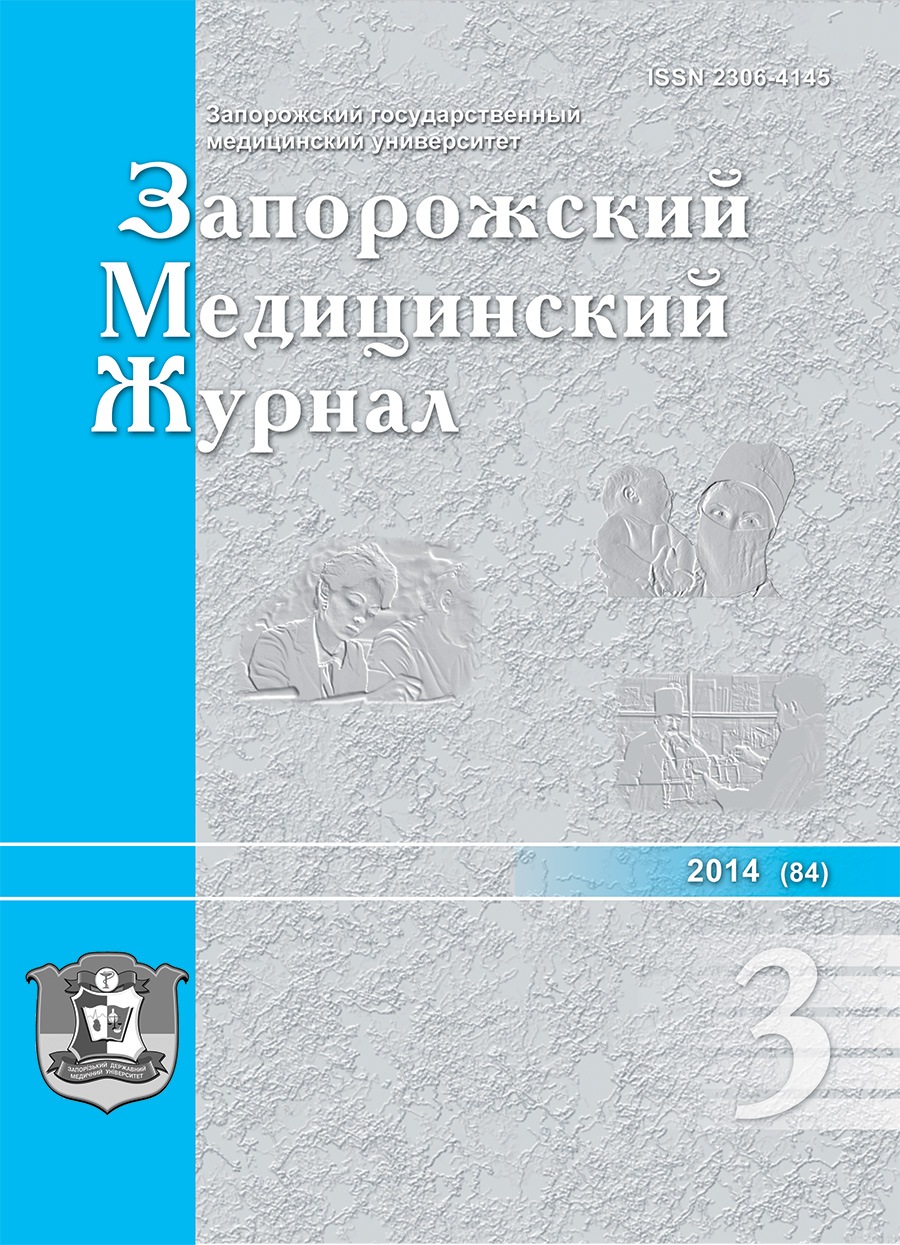Acute myocardial infarction in patient with myocardial bridging
DOI:
https://doi.org/10.14739/2310-1210.2014.3.26062Keywords:
Pathologic Processes, myocardial bridging, myocardial infarctionAbstract
Aim. Clinical event of acute myocardial infarction in patient of 22 as a result of intermittent compression of anterior interventricular branch of left coronary artery caused by myocardial bridging was described.
Methods and results. Diagnosis of myocardial infarction was taken for reasons given clinical signs, dynamics of ischemic ECG changes and markers of myocardial necrosis. Presence of myocardial bridging in middle one-third of anterior interventricular branch of left coronary artery was confirmed by coronarography.
Conclusion. This сlinical event shows possibility of development of acute myocardial infarction in younger patients with myocardial bridging in physical overload leads to significant systolic compression of coronary artery.
References
Belov, Yu. V., & Bogopolskaya, О. М. (2004) Miokardial'nyj mostik – vrozhdennaya anomaliya koronarnogo rusla [Myocardial Bridge – Congenital Anomaly of Coronary Vasculature]. Cardiologia, 12, 89–94. [in Russian].
Bokeriya, L. A., & Berishvili, I. I. (2003) Khirurgicheskaya anatomiya venechnykh arterij [Surgical anatomy of coronary arteries]. Мoscow, NCSSKH im. А. N. Bakuleva RАМN. [in Russian].
Bokeriya, L. А., Bokeriya, O. L., & Tetvadze, I. V. (2010) Miokardial'nye myshechnye mostiki. E`mbriologiya, anatomiya, patofiziologiya. Literaturnyj obzor [Miocardial muscle bridging. Embryology, anatomy, pathophysiology. Literary review]. Bulleten` Nauchnogo Centra serdechno-sosudistoj khirurgii im. А. N. Bakuleva RАМN, 6(1), 62–79. [in Russian].
Knyshov, G. V., Gogayeva, E. K., Rudenko, A.V., Dzakhoyeva, L. S., Lazorishinec, V. V., Panichkin, Yu. V., & Salo, S. V. (2006) Nyryayushhie arterii – norma ili patologiya? [Diving arteries — norm or pathology?] Mezhdunarodnyj medicinskij jurnal, 1, 52–59. [in Russian].
Escaned, J., Bañuelos, C., Sabaté, M., Fernández-Ortiz, A., Hernández, R., Alfonso, F., et al. (2003). Importance of diastolic fractional flow reserve and dobutamine challenge in physiologic assessment of myocardial bridging. Journal of the American College of Cardiology, 42(2), 226–233. doi:10.1016/S0735-1097(03)00588-6.
Lozanoa, I., Bazb, J. A., Palopa, R. L., Pinara, E., Picóa, F., Valdésa, M., et al. (2002) Long-term prognosis of patients with myocardial bridge and angiographic milking of the left anterior descending coronary artery. Rev. Esp. Cardiol, 55(4), 359–364.
Loukas, M., Kriegenbergh, K. V., Gilkes, M., Tubbs, R. S., Walker, C., Malaiyandi, D., et al. (2011). Myocardial bridges: A review. Clinical Anatomy, 24(6), 675–683. doi: 10.1002/ca.21150.
Duygu, H, Zoghi, M., Nalbantgil, S, Kirilmaz, B, Türk, U, Ozerkan, F, et al. (2007) Myocardial bridge: a bridge to atherosclerosis. Anadolu Kardiyol Derg, 7(1), 6–12.
Brodsky, S. V., Roh, L., Ashar, K., Braun, A., & Ramaswamy, G. (2008). Myocardial bridging of coronary arteries: A risk factor for myocardial fibrosis? International Journal of Cardiology, 124(3), 391–392.
Arjomand, H, AlSalman, J, Azain, J, & Amin, D. (2000) Myocardial bridging of left circumflex coronary artery associated with acute myocardial infarction. J. Invasive Cardiology, 12(8), 431–434.
Bourmayan, C, Desnos, M, Guérot, C. (2001) Myocardial bridge: description, significance, treatment. Arch. Mal. Coeur. Vaiss., 94(7), 681–684.
Egred, M., Viswanathan, G., & Davis, G. (2005) Myocardial infarction in young adults. Postgrad. Med. J., 81(962), 741–745.
Kunamneni, P. B., Rajdev, S., Krishnan, P., Moreno, P. R., Kim, M. C., Sharma, S. K., et al. (2008). Outcome of intracoronary stenting after failed maximal medical therapy in patients with symptomatic myocardial bridge. Catheterization and Cardiovascular Interventions, 71(2), 185–190.
Ishikawa, Y., Kawawa, Y., Kohda, E., Shimada, K., & Ishii, T. (2011). Significance of the Anatomical Properties of a Myocardial Bridge in Coronary Heart Disease. Circulation Journal, 75(7), 1559–1566.
Hill, S. F., & Sheppard, M. N. (2010). Non-atherosclerotic coronary artery disease associated with sudden cardiac death. Heart, 96(14), 1119–1125. doi: 10.1136/hrt.2009.185157.
Bourassa, M. G., Butnaru, A., Lespérance, J., & Tardif, J. (2003). Symptomatic myocardial bridges: overview of ischemic mechanisms and current diagnostic and treatment strategies. Journal of the American College of Cardiology, 41(3), 351–359. doi:10.1016/S0735-1097(02)02768-7.
Konen, E, Goitein, O, Sternik, L, Eshet, Y, Shemesh, J, Di Segni, E. (2007) The prevalence and anatomical patterns of intramuscular coronary arteries a coronary computed tomography angiographic study. J. Am. Coll. Cardiol., 49(5), 587–593. doi:10.1016/j.jacc.2006.09.039.
Teragawa, H., Fukuda, Y., Matsuda, K., Hirao, H., Higashi, Y., Yamagata, T., et al. (2003). Myocardial bridging increases the risk of coronary spasm. Clinical Cardiology, 26(8), 377–383.
Downloads
How to Cite
Issue
Section
License
Authors who publish with this journal agree to the following terms:
Authors retain copyright and grant the journal right of first publication with the work simultaneously licensed under a Creative Commons Attribution License that allows others to share the work with an acknowledgement of the work's authorship and initial publication in this journal. 
Authors are able to enter into separate, additional contractual arrangements for the non-exclusive distribution of the journal's published version of the work (e.g., post it to an institutional repository or publish it in a book), with an acknowledgement of its initial publication in this journal.
Authors are permitted and encouraged to post their work online (e.g., in institutional repositories or on their website) prior to and during the submission process, as it can lead to productive exchanges, as well as earlier and greater citation of published work (See The Effect of Open Access)

